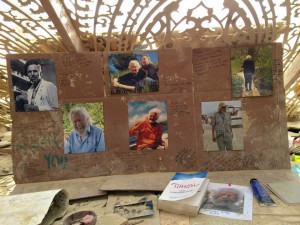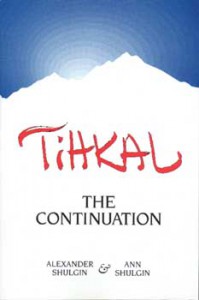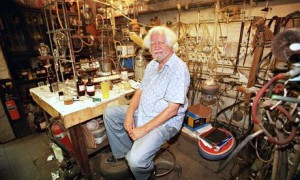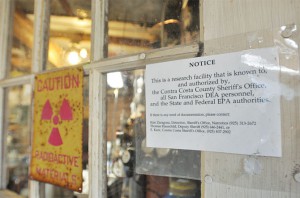Sasha’s Metanoia
Recently, I awoke from a dream in which Sasha and I were sitting high up over a shoreline watching the sunset out west of us. It had been a large family gathering and Sasha, though old and frail, was in his usual ebullient mood.
The conversation had left psychedelics and chemistry long ago and we were talking of the psychological transformations that had been or were occurring for him as the sun set on his life. Do psychedelics prepare one for death? This was a question Terence had left me with shortly before he died in the spring of 2000. He had answered it in the affirmative: “And we psychedelic people, if we could secure that death has no sting, we would have done the greatest service to suffering intelligence that can be done.”
The conversation I was having with Sasha in my dream had no sting for either of us. When I asked him if he still thinks of “next year I’ll do this or that …”, he looked at me and smiled peacefully: he had already forgot the question. He was here and now, in my dream … and then he was gone.
I awoke and shared my dream with Charlotte. It is very rare I talk about dreams at all. There’s too much to focus on in the waking state, too much to piece together here and now than to witter on about shards of broken pottery from a dream. But this dream had echoed something Greg Manning, of Team Shulgin, had said at Sasha’s memorial in Berkeley about the childlike innocence of Sasha’s early dementia. Greg had asked him to repeat something he had just said. Sasha replied: “Oops! Can’t remember.” Greg then asked him “How does that feel, Sasha, to not have all that stuff running around in your brain anymore?” Sasha said, “It’s very freeing. I am in shy amazement of the world in front of me that I haven’t touched yet.”
For me it was this innocence, this wondrous curiosity for discovery, this unabashed shameless pursuit of knowledge, that impressed me most about Sasha, particularly when he applied it to psychedelic chemistry. He put in a solid 50 years at the lab bench. What could motivate a man to such efforts?
Of his first psychedelic experience Sasha said in PiHKAL:
“The most compelling insight of that day was that this awesome recall had been brought about by a fraction of a gram of a white solid, but that in no way whatsoever could it be argued that these memories had been contained within the white solid. Everything I had recognized came from the depths of my memory and my psyche. I understood that our entire universe is contained in the mind and the spirit. We may choose not to find access to it, we may even deny its existence, but it is indeed there inside us, and there are chemicals that can catalyze its availability.”
Upon my arrest, for catalyzing the availability of said chemicals, Sasha’s work, his words and his attitude gave me the courage to stand and fight — without excuse or shame or special pleadings — for what it means to be truly free. Indeed, this was the theme of Sasha’s memorial, that we should follow his lead, as Mariavittoria Mangini so eloquently put it: “if as I suspect is true, our psychedelic experiences have had lifelong implications, not only for our personal growth and our spiritual development, but also for our community involvement and our political activism, we should stand up and claim those experiences as influential in our lives”. We should own it.
Reflecting this, I opened my original defense arguments at trial quoting Sasha from the preface of TiHKAL:
“As in the past, the people who lead us are fueled by the archetype of power, that aspect of the human psyche which drives to structure, control, and formulate rules and systems. The power drive shapes our world, and without it, mankind would have perished long ago. When it is kept in balance with its several complementary energies, it gives us form; it builds civilizations. But when the precarious balance is shifted, and too much energy flows from this archetype, structure becomes constriction, control becomes dictatorship, teaching degenerates into admonition and threat, vision and intuition create dogma, and caution evolves into paranoia. Communication with the loving and nurturing energy within us is lost, and with it the ability to choose wisely, either for ourselves individually or for our species.
Priests and kings, emperors and presidents, and all those who find comfort and safety within the structures maintained by the powerful, tend to be disturbed and angered by the individuals who insist on striking off in new directions, ignoring the guidance of appointed leaders. To those in authority, there is the unconscious threat of chaos, the shattering of what is known, familiar, and safe. The response to this threat can take many forms, from killing the offender (witch-burning) to — at the very least — warning him to keep his knowledge and opinions to himself (as with Galileo), lest they provoke the self-protective anger of the established order and of those who maintain power through it.
This has been the history of human development on this earth, a balance maintained — usually with great difficulty and often with violence — between the urge to control and the need to change and grow. And this is the way it should have been able to continue, but the technological growth-spurt of the past fifty years has put mankind’s hands a body of knowledge that changes the equation. However, just as the nuclear and chemical warfare genies are out of the bottle, never to be put back again, so also will the psychedelic genie be forever amongst us.
Being human means being a soul that chooses — consciously or unconsciously — what it will do and what it will become. For my part, I prefer as much awareness as I can achieve in this lifetime, in order to make my choices wisely”.
Instead of claiming I didn’t do it, I stood there before the jury unashamed that I had found awareness, mindfulness, insight, and wisdom through the molecular genies that had escaped his flask and now mine. How could I be but otherwise when so gracious a gentle giant had shown me this way of being in relentless pursuit of knowledge and wisdom?
While I am not sure I can put it faithfully into words, what Alexander T Shulgin became for me — especially upon my arrest — is rooted in his intentionality and integrity. Sasha was a true hero in the Campbellian sense: even after the DEA raided his lab and took away his license to work with controlled substances he gleefully continued to share the knowledge gleaned from these molecules, actively promoting them as tools of insight-wisdom with anybody who would listen and potentially act. He was committed to a more loving and nurturing world and he was convinced that psychedelics were essential tools to accomplish that.
Over and over, like a mantra Sasha would say, “All I am is a tool maker, people use my tools to unlock doors and access rooms full of knowledge and wisdom and spirituality that already exist within them. I am just a tool maker”. Sasha, you were way more than that to me: you were a pioneer of Cognitive Liberty, a shameless promoter of the conscious exploration of what Huxley called the antipodes of the mind, and above all you were my model of a responsible steward of the genies that escaped my flask.
And it was to celebrate this greatness that over a thousand people flocked to Sasha’s memorial: most of us will be lucky to rustle up the requisite pallbearers to carry our coffin. As Earth and Fire Erowid related “in order to stay connected to the world, you need to keep and make friends of all ages … Gatherings at the Shulgin’s home always included an amazing array of students, teachers, professionals, researchers, and policy makers from young to old”. Getting to such an old age and yet still having such a spectrum of admiring celebrants is so rare. As Amanda Feilding said: “So brilliant of Sasha to not only live his life perfectly but also to have a perfect death surrounded by the people he loved … He’s a wonderful example to us all”.
For some, however, especially those whose children have died whilst consuming MDMA or other molecules his flask had first liberated, Dr Shulgin is not seen in such glowing light. As the United Kingdom’s Observer on Sunday reported after his death:
“It was not Shulgin’s intention to launch a global drug culture, nor to have that compound consumed with such abandon by millions of people. But it was his connection with this drug that made him a folk hero for the counterculture, known as the “godfather of ecstasy”, and a folk devil for many outside it.”
In my opinion, it is not fair to lay these unintended consequences at his feet rather than at the feet of those prosecuting a Frankensteinian ‘War on some people who use some Drugs’. For the problems associated with MDMA particularly are most often related to enforcement of that failed policy.
In the UK, in the early 90s, many “Ecstasy” users died from overheating when the police cracked down on the now unlawful outdoor rave scene: the ravers moved indoors, the dance floors blazed, the club-owners shut off the water taps whilst charging outrageous prices for tiny bottles of water, because they weren’t selling enough alcohol. Eventually, the UK Government mandated the provision of free tap water at such indoor venues, yet, ironically, in the heat of the night, the harm reduction message to drink plenty of water would lead to people effectively drowning in their own skin from “hyponatremia (literally “low salt”) also called “water intoxication”.
And then there are the adulterants, how could Sasha be held responsible for the acts of unscrupulous dealers out to make more money? A quick look at EcstasyData.org will inform one of how often the prohibitionist policy leads to adulterated or intentionally mislabeled pills and powders, a problem that would all but disappear with a regulated lawful supply of a drug essential to the coming of age of many. I know MDMA was essential to mine.
At Sasha’s memorial, Bob Jesse asked all of us to reflect on an especially influential occasion when we might have ingested one of Sasha’s compounds. Bob then asked “Can you imagine how your life might have unfolded without it? I have no idea, Bob. I could make all sorts of shit up, but, I became a psychedelic chemist because I wanted in some way to be like Sasha. I too wanted to catalyze, with the aid of molecular genies, entheogenesis in others. So, I too became a tool maker.
More important than who I would be without MDMA Sasha’s magic half-dozen, where would whole cultures be? It’s rare to experience an advertisement on the radio, television or internet without the sounds, imagery and emotions of the ‘Rave Culture’ permeating one’s brain: this is your brain on drugs, maybe not by direct ingestion, but by associative suggestion. As the UK Independent newspaper reported in a 2012 article ‘Rave On’, celebrating the 20th anniversary of the zenith of ‘Rave Culture’:
“Rave’s transformation of club culture turned it into a global force that influences just about every other pop genre. It has created a thriving branch of the entertainment industry and helped break down sexual and racial divides. Yet such an outcome would have been hard to predict when the authorities broke up Castlemorton, arresting a motley crew of crustie travellers and pilled-up ravers”.
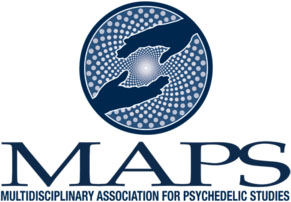 And then there is MAPS, the Multidisciplinary Association for Psychedelic Studies. Would MAPS even exist had Rick Doblin, its founder, not consumed “the Godfather’s” delight? Rick too has the intentionality and integrity I admired in Sasha. With MAPS, Rick knew he would make history, if only in slow-motion. As many of you are aware, in the beginning MAPS sought not only to promote MDMA as a psychotherapeutic medicine but also asked us to envision “a cultural reintegration of psychedelics and the states of mind they engender”. Today, MAPS is known around the world for its successes in turning the first part of that vision into reality: among other things, MDMA is being used lawfully in PTSD therapy, in government-approved research trials. When Rick’s vision comes to full fruit, and I am sure it will, it will have taken 30 plus years of dedicated effort by him and the team he has assembled.
And then there is MAPS, the Multidisciplinary Association for Psychedelic Studies. Would MAPS even exist had Rick Doblin, its founder, not consumed “the Godfather’s” delight? Rick too has the intentionality and integrity I admired in Sasha. With MAPS, Rick knew he would make history, if only in slow-motion. As many of you are aware, in the beginning MAPS sought not only to promote MDMA as a psychotherapeutic medicine but also asked us to envision “a cultural reintegration of psychedelics and the states of mind they engender”. Today, MAPS is known around the world for its successes in turning the first part of that vision into reality: among other things, MDMA is being used lawfully in PTSD therapy, in government-approved research trials. When Rick’s vision comes to full fruit, and I am sure it will, it will have taken 30 plus years of dedicated effort by him and the team he has assembled.
And without Sasha and the financial support of fellow psychonauts worldwide, how would the Erowid Center have come into existence? How would you be reading this? It appears to me that Earth and Fire might have been touched within by one or more of Sasha’s creations and thus motivated, for the last seventeen years, t o illuminate the dearth of information about these molecules, their possibly wondrous benefits and their potential deleterious effects. Today, Erowid receives over 15 million annual unique visitors. Their intentionality and integrity impresses me the most. The Erowid Prospectus states, among other things:
o illuminate the dearth of information about these molecules, their possibly wondrous benefits and their potential deleterious effects. Today, Erowid receives over 15 million annual unique visitors. Their intentionality and integrity impresses me the most. The Erowid Prospectus states, among other things:
“Erowid Center’s mission is to develop and provide access to accurate information about psychoactive plants, chemicals, pharmaceuticals, and technologies in order to educate, improve health, and encourage beneficial cultural reform. […] A great deal of wisdom has developed over the last fifty years about the best ways to integrate the use of psychoactive drugs into a good life. Now is the time to collect and widely disseminate successful models for healthy psychoactive use. … Erowid’s response is the creation of an online hybrid library/research journal … ”
So few of us will dedicate ourselves to such a noble pursuit that we will invest so many years. Most of us will lose sight of the wisdom gleaned from the psychedelic experience to the vicissitudes of the ego in normal waking life. As Scott Bodarky said at the memorial:
“Sasha Shulgin was perhaps the last renaissance man, citizen scientist, working in his shed, out in the yard, fueled by his curiosity, the love of the truth. […] Sasha’s work was about catalyzing the deepest longing of the human heart: to know itself. […] Every human being must undergo ego death, at physical death, if not before. Sasha systematically developed technology dedicated to facilitating this evolution. Perhaps one day, pharmacological self-determination will be a human right”.
Scott, I too pray it will. Is Sasha’s legacy as Nick Saunders said? Is it true that because of Sasha, “psychedelic exploration can never be controlled again”? What started with a curious psychonaut has expanded globally.
As I write this, the Temple burns tonight into the impermanence, to which, we, like Sasha, all must return; thousands of revelers are under the influence of molecules that Sasha either rediscovered, invented or resynthesised. Like the many clandestine chemists and drug geeks who produced the molecules coursing their veins, I too relied on Sasha’s works to make those molecules or to give me ideas on how to make them. And though he is gone, his books, his words, his thoughts, are available online, free and now. Sasha Shulgin has become as immortal as one can. Sasha’s immortality project is complete.
*
In the Denial of Death, Ernest Becker wrote:
“Man is literally split in two: he has an awareness of his own splendid uniqueness in that he sticks out of nature with a towering majesty, and yet he goes back into the ground a few feet in order to blindly and dumbly rot and disappear forever. It is a terrifying dilemma to be in and to have to live with. […] The knowledge of death is reflective and conceptual, and animals are spared it. […] But to live a whole lifetime with the fate of death haunting one’s dreams and even the most sun-filled days—that’s something else.”
Terence died of brain cancer at 53, the doctors said it wasn’t related to his copious psychedelic use; but, I wondered if they could be right. Sasha was nearly 89, he had taken a lot of psychedelics, he had dementia but it came late. Like a psychedelically influenced ego-death, Sasha’s dementia, as related by Greg above, posits a possible return to wonder. Is it our awareness of our mortality that squelches that innate wonder in so many? Is this what motivates our relentless substance race? Is this why an experience of ego-death appears so essential to taking the sting out of death?
The King is dead but he’s not forgotten!
Casey x


